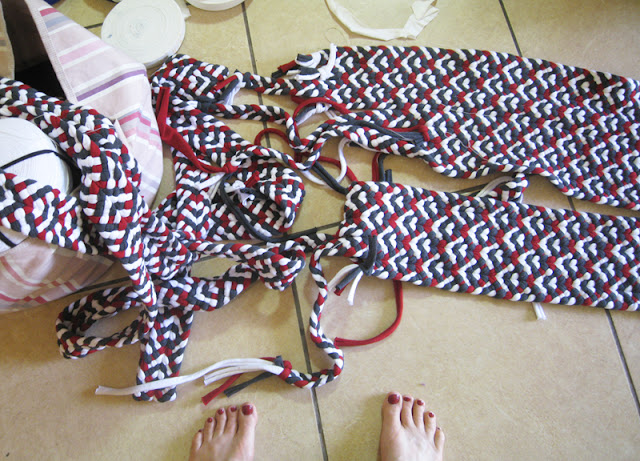Vi vill presentera
Jothi och
Chitra som flätat
Re Rag Rug II
De är systrar, båda är gifta och har små barn. De bor nära varandra i staden Tirupur i Indien och träffas ofta.
Båda kvinnorna har utbildning på gymnasienivå (12th standard) med matematik respektive vetenskap som huvudämnen. Efter studierna har de gått datakurser och arbetat några år, båda som lärare i vissa ämnen, innan de gifte sig och bildade familj.
Chitra har också arbetat på med administration på ett trikåföretag.
Ytterligare gemensamt, också med de flesta andra kvinnor i Indien är att de slutat arbeta när de fått barn. För att hinna med sina uppgifter i hemmet; ta hand om barn före och efter skolan, hushållssysslor och se till att mannens föräldrar som ofta bor hos någon av sönerna är omhändertagna och nöjda.
De skulle gärna vilja arbeta deltid men inga arbetsgivare är intresserade av deltidsarbetare i Tirupur.
Hemarbete skulle kunna vara ett sätt att bidra till familjens försörjning.
Vi frågar hur de känner inför att åta sig uppdraget med fläta våra mattor, de kunde ju kanske hitta något annat område, t ex telefonförsäljning som blir allt vanligare.
Det glädjande svaret är att de tycker att handarbete är så intressant. De kan sticka och brodera lite men vill gärna lära sig mera. -Så lika vi är!
Utöver det säger Chitra att de tycker att det är roligt men också 'it is mind relaxation'. I en vardag med stress är det avkopplande att handarbeta.
Vi kan inte annat än att hålla med.
 |
| Chitra |
 |
| Jothi |
We would like to introduce Jothi and Chitra who made Re Rag Rug II
They are sisters, both married and have small children. They live near eachother in the city of Tirupur in India and they meet often.
Both women have studied up to 12th standard with mathematics and science as mayor subjects. After their studies they have attended computer classes. Before marrying they have worked a few years, both teaching their. Chitra has also worked with adminisration in a T-shirt factory.
They have in common with many other women in India that they stoped working when becoming mothers in order to manage all their household duties: caring for the children as well as making sure the inlaws (who often live with one of the sons) are content.
They would like to be able to work part-time but this is not common in India and not interesting for employers in Tirupur.
Working from home would be a way of contributing economically to the household. We ask how they feel about taking on the job to make a rugs as they could maybe find work in telephone sales, something which is increasing in India and something that could also be done from home.
The answer is so pleasing to us. They think handicraft is interesting. Thay can knit and embroider a little and would like to learn more. -So similar we are!
Apart from it being fun, Chitra says that she thinks it is 'mind relaxation'. In a stressful life handicrafts has the power to bring peace to your mind. We can't but agree.














